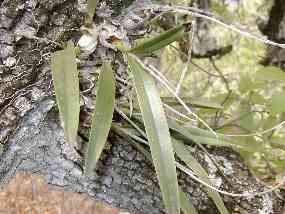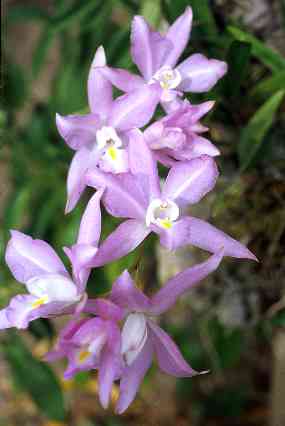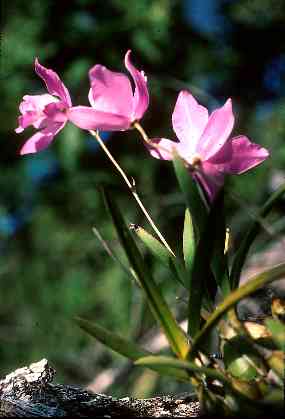Research and Conservation in Southern Sonora, Mexico
Laelia eyermaniana (quiqui, flor de los santos)
 Laelia eyermaniana on an oak branch, Rancho Santa Bárbara, Sonora. Photo: Martín G. Figueroa |
Creeping rhizomes produce small pseudobulbs topped with one or two long, narrow, leathery leaves. Clusters of several rose-pink flowers are borne in October and have a slight fragrance.
Of the epiphytic orchids of Sonora, this species grows in the highest, coolest habitats. Found mostly on oak trees in oak woodland. Locally common.
 Laelia eyermaniana flowering in cultivation. Photo: Mark Dimmitt |
 Laelia eyermaniana flowering on an oak tree northeast of Alamos, Sonora. Photo: George M. Ferguson |
Description: Rhizomes very short. Pseudobulbs clustered, 3.7-6.5 cm long, 1.2-1.9 cm wide, narrowly ovoid. Leaves mostly 2, sometimes 1, linear, thick and leathery, (9.6-) 12.5-21 cm long, 10.8-20.3 mm wide, 1.1-1.6 mm thick. Flowering stalks 22-53 cm long, racemose, (1) 2-5-flowered. Flowers subtended by a brown, scarious, subulate-triangular, clasping scale, these longer on lowermost flowers and shortest on uppermost flowers, 14.4-7.5 mm long. Pedicellate ovary 18-30 mm long.
Flowers showy, with a pleasant, moderately spicy fragrance, often 9-10 cm wide, of rose-pink, very rarely white, the sepals and lateral petals spreading. (The following measurements taken from flattened flowers, and refer to fresh, living specimens). Sepals 37-50 mm long, 10.6-16 mm wide, lanceolate to lance-oblong or slightly oblanceolate, the tips moderately recurved, the apex acute, darker purple or green, the dorsal sepal slightly larger than the lateral sepals.
Lateral petals broadly ovate-elliptic to obovate, 38-50 mm long, 16.5-27 mm wide, the margins slightly ruffled or undulate, the apex obtuse. Lip petal 33-38 mm long; callus yellow distally, white proximally, with 3 keels continuing basally (proximally) into dark purple dot and dash guide lines, the middle keel becoming obsolete posterior to the yellow callus area--the high part of the middle keel lies just below the rostrum, forcing the bee upwards to contact the stigmatic surface and pollinia in the rostrum; middle lobe rose-pink, 18-22 mm long, 15-18 mm wide, narrowed at base, obovate with slightly ruffled margins, the apex rounded to slightly emarginate or short-apiculate; lateral lobes thicker than the middle lobe, sepals and lateral petals, white, upcurved and parallel, 22-25.5 mm long, 11-14.5 mm wide. Column 21-25 mm long, white, or with a few purplish spots basally or rose pink dorsally, especially towards apex. Body of fruit 3-4 cm long, the dry perianth persistent. October; fruits March to June.
Equable, moist, airy slopes. Oak forest and pine-oak forest; 1200-1800 m. SE Sonora, SW Chihuahua, Sinaloa, Durango, and Michoacán.
This Sonora-Chihuahua Laelia resembles L. autumnalis (Lex.) Lindley, but are smaller plants overall with fewer-flowered racemes, and shorter pedicellate ovaries. However, they do appear to be closely related.
"The Warihios use the mucilaginous sap of the bulbs as glue in making musical instruments, principally the violin. It is applied directly by rubbing the skinned bulb along the seam or wood surface to be jointed. There is a belief that where 'kiki' grows is no place to plant maize, for the maize will fail or do poorly." Most other pseudobulbed Río Mayo orchids are likewise used for making glue.
In cultivation it is heat-sensitive and difficult to grow in Tucson greenhouses.Reference: Felger, Richard S. and Mark A. Dimmitt. The orchids (Orchidaceae) of northwestern Mexico. Unpublished ms.